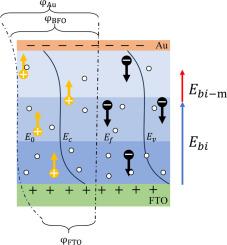引入由氧空位梯度分布诱导的内置电场来驱动高性能bifeo3基自供电光电探测器
IF 5.7
3区 材料科学
Q2 MATERIALS SCIENCE, MULTIDISCIPLINARY
引用次数: 0
摘要
由于其独特的铁电光伏特性,铋铁氧体(BiFeO3)是小型化和高集成度自供电光电探测器的理想候选材料。本研究利用(La, Ni)梯度掺杂BiFeO3多层薄膜设计并构建了一种新的器件结构,实现了高性能的自供电光电探测器。例如,该光电探测器的响应率为18.7 mA/W,探测率为9.12 × 108 Jones,性能是无梯度结构器件的2 ~ 4倍。提出了一个潜在的机制,即梯度掺杂在多层膜中引入了氧空位和晶格的空间梯度,从而产生了两个新的梯度电场(氧空位梯度场和柔性电场)。这些内置电场的耦合极大地促进了光生载流子的分离,从而提高了光电流密度,从而大大提高了光电探测器的光伏和光响应性能。本文章由计算机程序翻译,如有差异,请以英文原文为准。

Introduction of built-in electric fields induced by oxygen vacancy gradient distribution to drive high-performance BiFeO3-based self-powered photodetectors
Due to the unique ferroelectric photovoltaic properties, Bismuth Ferrite (BiFeO3) is an ideal candidate for miniaturized and high-integration self-powered photodetectors. In this study, a new device structure was designed and constructed using (La, Ni)-gradient-doped BiFeO3 multi-layers film for achieving a high-performance self-powered photodetector. For instance, such a photodetector achieved a responsivity of 18.7 mA/W and a detectivity of 9.12 × 108 Jones, whose performance is 2 to 4 times those of devices without a gradient structure. An underlying mechanism was proposed that the gradient doping introduced a spatial gradient of oxygen vacancies and lattice in the multilayers film, which in turn generated two novel gradient electric fields (oxygen vacancy gradient field and flexoelectric field). The coupling of these built-in electric fields significantly facilitated the separation of photogenerated carriers and thus enhanced the photocurrent density, which greatly improved the photovoltaic and photoresponse performance of photodetector.
求助全文
通过发布文献求助,成功后即可免费获取论文全文。
去求助
来源期刊

Materials Research Bulletin
工程技术-材料科学:综合
CiteScore
9.80
自引率
5.60%
发文量
372
审稿时长
42 days
期刊介绍:
Materials Research Bulletin is an international journal reporting high-impact research on processing-structure-property relationships in functional materials and nanomaterials with interesting electronic, magnetic, optical, thermal, mechanical or catalytic properties. Papers purely on thermodynamics or theoretical calculations (e.g., density functional theory) do not fall within the scope of the journal unless they also demonstrate a clear link to physical properties. Topics covered include functional materials (e.g., dielectrics, pyroelectrics, piezoelectrics, ferroelectrics, relaxors, thermoelectrics, etc.); electrochemistry and solid-state ionics (e.g., photovoltaics, batteries, sensors, and fuel cells); nanomaterials, graphene, and nanocomposites; luminescence and photocatalysis; crystal-structure and defect-structure analysis; novel electronics; non-crystalline solids; flexible electronics; protein-material interactions; and polymeric ion-exchange membranes.
 求助内容:
求助内容: 应助结果提醒方式:
应助结果提醒方式:


